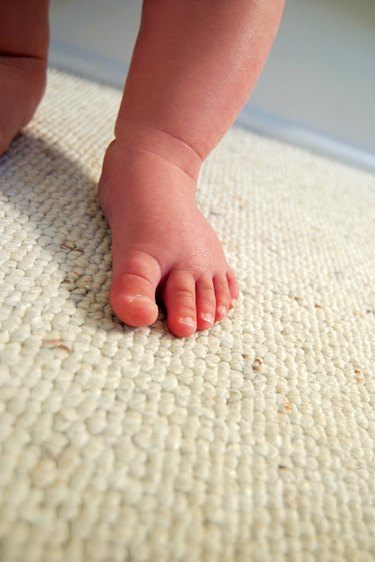
If you have an infestation of bugs following a new carpet installation, you might have a problem with carpet beetles. These insect pests feed on animal fibers like wool and mohair, which carpets may be made from. Carpet beetles are found in many places, including in warehouses where carpeting is stored. Adult beetles aren't a problem. However, their hungry larvae cause serious damage to fabrics when they hatch.
Description
Video of the Day
Adult carpet beetles are small oval-shaped insects that grow about 1/8 inch long. They can be black, brown or have variegated coloring, depending on the species. Carpet beetle larvae are long, reddish-brown bugs that are usually covered with tufts of hair and vaguely resemble duff millipedes. Larvae shed their skins as they grow and these skins are sometimes mistaken for living larvae.
Video of the Day
Damage
Adult beetles feed on pollen, but the larvae eat animal-based materials like wool, silk, feathers, hair, bristles and furs that are found in carpeting, upholstery, clothing and household items. Beetle larvae don't eat synthetic fibers, but they will attack synthetic blends that contain animal-based fibers. They also eat stored foods like flour, cereal and cornmeal as well as preserved specimens. Look for larvae in dark, undisturbed areas like closets, attics and storage trunks or carpet areas under furniture. Items that are in regular use aren't usually disturbed. Damage caused by carpet beetles can be confused with that caused by clothes moths. However, beetles usually damage a large area of a garment while moth damage consists of scattered holes.
Entry
Carpet beetles enter your home in many ways. Larvae can crawl from one apartment to another, and adults may enter on cut flowers. Adult beetles are especially fond of flowers that produce a lot of pollen, including crape myrtle and spiraea. Eggs may be found on toys, trophies, natural-bristle brushes, second-hand furniture, carpets and clothing that come into the house from other places. According to horticulturists at Colorado State University Cooperative Extension, most household infestations probably come from beetles that are in the wild. When adult beetles enter homes, they lay eggs in places where dead insects and lint accumulate, such as in air ducts or underneath baseboards.
Control
Carpet beetles are very hard to control because they can spread throughout a building and find food in out-of-the-way spots. Sticky traps, which are available from retail stores, can be placed throughout your house to ascertain where the beetles are coming from. Vacuum rugs and upholstery regularly to remove eggs before the larvae hatch. Vacuum storage areas and decorative needlework hanging on the walls. Store clothing in containers with tight lids. Apply insecticides, if necessary, to cracks and crevices. Don't spray them on walls or shelves. Infested carpets can be sprayed but clothing and bedding should not be. Wash infested clothing in hot water or have it dry-cleaned. Infested items can also be stored in a freezer at zero degrees Fahrenheit for a minimum of 48 to 72 hours to kill pests.
- New Mexico State University College of Agriculture; Preventing Damage from Clothes Moths and Carpet Beetles; Susan Wright
- Colorado State University Extension; Carpet Beetles; W.S. Cranshaw; January 2008
- University of California Statewide Integrated Pest Management Program; Carpet Beetles; April 2001
- University of Florida Cooperative Extension; Carpet Beetles; P. G. Koehler, et. al.